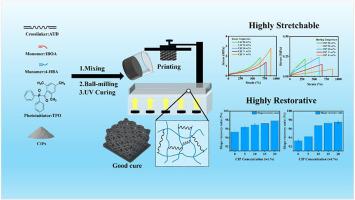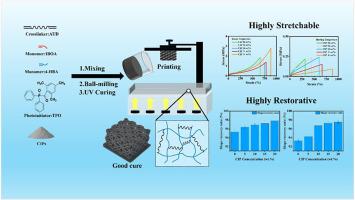Highly stretchable, magnetic responsive, shape memory polymer composites via digital light processing 3D printing: Synthesis, characterization and applications
IF 4.5
2区 化学
Q2 POLYMER SCIENCE
引用次数: 0
Abstract
Shape Memory Polymers (SMPs) have emerged as a promising class of intelligent materials because of their unique ability to respond to external stimuli. The proposed method for fabricating magnetic shape-memory polymer composites (DLP-M-SMPs) using digital light processing (DLP) 3D printing technology represents a significant advancement in this field. By combining the shape memory properties of SMPs with their magnetic responsiveness, these composites can overcome the limitations of traditional thermally driven SMPs, such as their narrow operating temperature ranges and poor adaptability to harsh environments. The DLP-M-SMPs developed in this study demonstrated remarkable mechanical properties and shape-memory performance. With a high elongation at break of 760 % at room temperature, these materials exhibit exceptional flexibility and durability. Shape fixation rates exceeding 96 % and shape recovery rates exceeding 99 % indicate their ability to reliably maintain and recover programmed shapes. Furthermore, the successful 3D printing of complex structures capable of shape recovery under magnetic actuation demonstrated the versatility and potential of these materials for various applications. This innovative approach for fabricating high-resolution, high-performance magnetic shape-memory materials opens up new possibilities in fields such as flexible robotics and biomedical engineering, where precise control and adaptability are crucial.


高度可拉伸,磁响应,形状记忆聚合物复合材料通过数字光处理3D打印:合成,表征和应用
形状记忆聚合物(SMPs)由于其独特的响应外部刺激的能力而成为一类有前途的智能材料。提出的利用数字光处理(DLP) 3D打印技术制造磁性形状记忆聚合物复合材料(DLP- m - smps)的方法代表了该领域的重大进步。通过将smp的形状记忆特性与磁响应性相结合,这些复合材料可以克服传统热驱动smp的局限性,例如工作温度范围窄,对恶劣环境的适应性差。本研究开发的DLP-M-SMPs具有优异的力学性能和形状记忆性能。室温下断裂伸长率高达760%,这些材料具有优异的柔韧性和耐用性。形状固定率超过96%,形状恢复率超过99%,表明它们能够可靠地保持和恢复程序形状。此外,能够在磁驱动下恢复形状的复杂结构的成功3D打印证明了这些材料在各种应用中的多功能性和潜力。这种制造高分辨率、高性能磁性形状记忆材料的创新方法为柔性机器人和生物医学工程等领域开辟了新的可能性,在这些领域,精确控制和适应性至关重要。
本文章由计算机程序翻译,如有差异,请以英文原文为准。
求助全文
约1分钟内获得全文
求助全文
来源期刊

Polymer
化学-高分子科学
CiteScore
7.90
自引率
8.70%
发文量
959
审稿时长
32 days
期刊介绍:
Polymer is an interdisciplinary journal dedicated to publishing innovative and significant advances in Polymer Physics, Chemistry and Technology. We welcome submissions on polymer hybrids, nanocomposites, characterisation and self-assembly. Polymer also publishes work on the technological application of polymers in energy and optoelectronics.
The main scope is covered but not limited to the following core areas:
Polymer Materials
Nanocomposites and hybrid nanomaterials
Polymer blends, films, fibres, networks and porous materials
Physical Characterization
Characterisation, modelling and simulation* of molecular and materials properties in bulk, solution, and thin films
Polymer Engineering
Advanced multiscale processing methods
Polymer Synthesis, Modification and Self-assembly
Including designer polymer architectures, mechanisms and kinetics, and supramolecular polymerization
Technological Applications
Polymers for energy generation and storage
Polymer membranes for separation technology
Polymers for opto- and microelectronics.
 求助内容:
求助内容: 应助结果提醒方式:
应助结果提醒方式:


